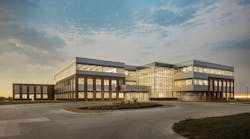Rebuilding Roebling Bridge
In order to easily reach and then remediate the Roebling Steel Plant in Roebling, NJ, an EPA Superfund site, WRS Infrastructure & Environment, Inc. called W.J. Castle, P.E. & Associates, P.C. to determine whether an abandoned steel railroad bridge crossing Crafts Creek could be converted into a roadway bridge able to support vehicles up to 110,000 pounds. After performing an in-depth inspection of the existing bridge, William J. Castle, P.E., company president and project manager, determined that by employing "green" engineering techniques a new bridge could, in fact, be reconstructed using bridge members and components already in place. Hydro-Marine Construction Company, Inc. was brought in to do the construction.
Repairing The Bridge's Concrete Substructure
After inspecting the existing bridge, Castle found its concrete substructure to be in fairly good condition. The exception was a voided area at the water line where the wingwall and the abutment joined together. Hydro-Marine prepared to fill the void by cleaning out the old concrete from the existing area, which measured approximately 4 feet wide by 8 feet high. Hydro-Marine then anchored flexible fiberglass forms to the face of the concrete. They then sealed off the bottom of the form with closed-cell neoprene forced under the form, which encased the entire void.
After installing epoxy-coated rebar, concrete was pumped in from the top. The fiberglass forms were left in place to provide additional protection for the area and prevent erosion in the future.
Rebuilding The Superstructure
The superstructure of the original bridge consisted of six steel stringers 37 feet 3 inches long. Castle explains that an in-depth inspection and subsequent analysis determined that these beams, with refurbishment, could be used on the new bridge to support the required loads.
"These were old steel beams," says Castle, "so we had to measure them to determine the size of the beams and the designation (ASTM A7 steel with a minimum yield strength of 30 KSI). We then analyzed the beams and found they were sufficient in strength and we could use them."
Although the steel beams were in overall fair condition, there was section loss and corrosion in the webs and flanges within the first 6 feet of each end of the beams. Both the steel stringers and the corroded bearing plates would need rehabilitation and repair prior to use. Hydro-Marine removed the existing diaphragms and beams, setting them aside to be prepared for installation.
The beams were thoroughly cleaned and 6-foot-long, 3/8-inch-thick steel bent plates were attached to each end on both sides to reinforce the deteriorated portions of the stringers. Also, Hydro-Marine welded new channel studs at 12-inch increments along the top of each stringer for a composite deck. Due to the deteriorated condition of the existing bearing plate and the different spacing of the beams on the redesigned bridge, a new bearing plate was installed along the length of the bridge seat and anchored into the concrete with 3/4-inch-diameter anchor bolts with 6-inch minimum embedment.
The original stringer configuration had been tightly spaced at the center of the concrete abutments for the railroad track with the fascia beams measuring approximately 8 feet 6 inches. However, WRS Infrastructure & Environment required a minimum clearance of 13 feet 6 inches to accommodate their vehicles. Therefore, the stringer spacing was expanded in the final design to approximately 13 feet 11 inches edge to edge of the fascia beams, which provided a clear roadway of approximately 14 feet 6 inches.
When the stringers were set in their final position, new diaphragms and 1-1/2-inch thick deck pans were installed, as well as a 1/4-inch-thick bent plate running along the top edges of the fascia beams. Steel guiderail posts were spaced at 6 feet 3 inches and attached to the beams with a 1/2-inch thick base plate and then to the bridge. All steel components of the bridge were covered in black shop paint with the exception of the galvanized guide rail. The 7-inch-thick composite-reinforced concrete deck was poured in place in less than one day.
Bill Castle points out that the new Roebling Bridge will be a key component in the cleanup of the site, providing access to an area that had previously been inaccessible.
No less important is the fact that W.J. Castle's design saved its client approximately $100,000 by rebuilding a bridge with existing components.
"The unique feature (of this bridge) was the green engineering. We basically rebuilt the bridge using most of the materials that were out there. We didn't have to build or construct a new foundation; we repaired the existing one. We didn't have to design new beams; we refurbished the existing ones, and then we poured the concrete deck."
Removal of the existing structure began in November 2008. The deck was poured the first week in January 2009, and the bridge opened to traffic on January 23, 2009.
|

